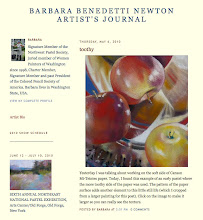I found another guinea pig painting for my oil and cold wax experimentation. I'm painting over old unvarnished paintings. This one was painted in 2020 and though it achieved the goals I was after at the time, I knew I would want to loosen it up at some point so I didn't apply varnish.
I began by mixing a more saturated version of the previous background color in oil with the addition of about 50% Dorland's Cold Wax Medium. After application tp the painting with a palette knife, I used the silicone bowl scraper to spread it out leaving some of the previous background color showing through.
I would like to show you progress photos but once I start mixing color with wax I am aware that the wax begins drying and since I am not adding solvent such as OMS, I try to work quickly. I paint quickly anyway so the process suits me. I finished the painting yesterday and posted it on Instagram. Just before bed I took another look at it and this morning I made adjustments. Once again, a very fun process for me, painting without a brush. See book information below that many of you have requested.
 |
| "Lo and Behold," oil and cold wax, 14 x 11 inches ©2021 Barbara Benedetti Newton |
Information from the publishers: More than just a technical guide, this 320-page, fully illustrated book provides comprehensive information for those who are new to cold wax, as well as technical expertise and inspiration to those already using the medium. The authors' advice and experience--along with the work and words of over 100 artists from around the world--will strengthen your work and studio practice, suggest exciting new directions, and support thoughtful self-critique. Rebecca Crowell and Jerry McLaughlin feel strongly that the "why" of using cold wax medium is as important as the “how.” Many of the artists whose work appears in the book speak about collaboration, process, and experimentation. The authors include their own thoughts about these topics, and more. And because readers also want clear information and direction for working with cold wax, large sections of the book are devoted to important practical information, including: materials, detailed lists of supplies, studio setup, illustrated how-to sections, and in-depth discussion of procedures. Book purchasers will also have exclusive access to additional bonus material available online.









